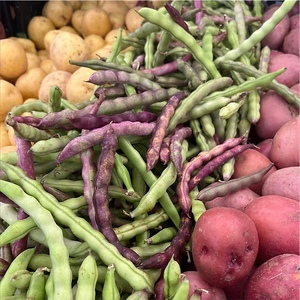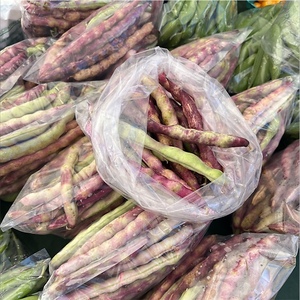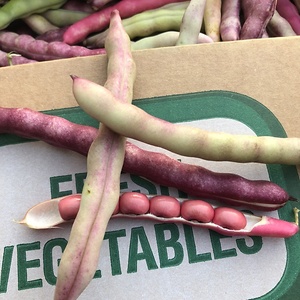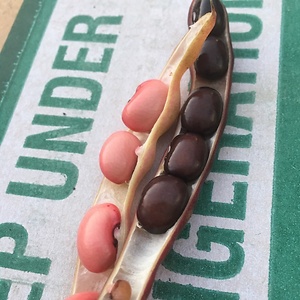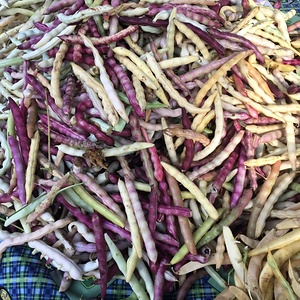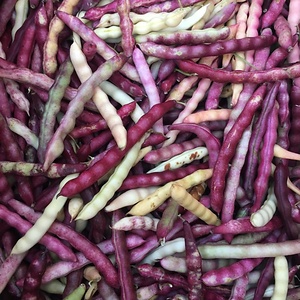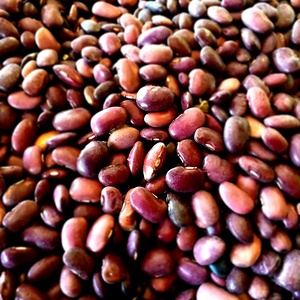

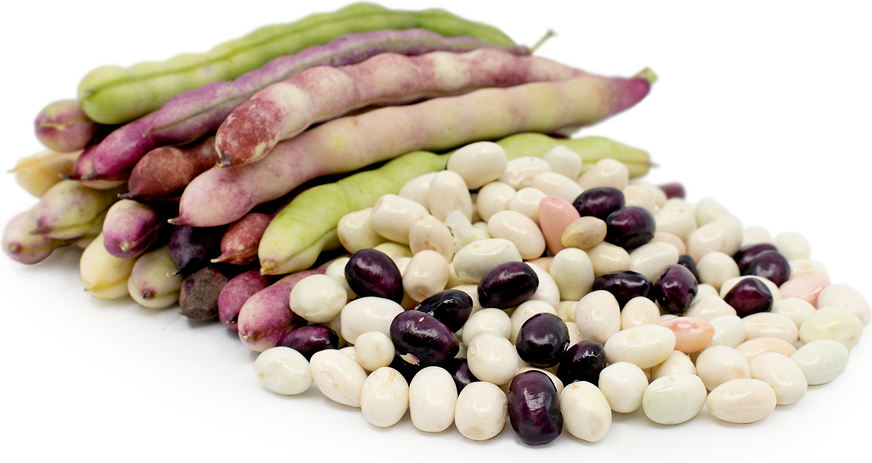
Oaxacan Shelling Beans
Estimated Inventory, lb : 0
Description/Taste
Oaxacan shelling beans are pod vegetables that have an elongated shape and bumps where their beans are located. Their pods can be either light green or burgundy-purple. The colored pods are somewhat transparent, revealing patches of off-white where the light-colored beans show through. Their skin is smooth and slightly wrinkled, becoming drier as the vegetable matures. When cooked, these pods turn a muted tan hue. Within the pods are beans that are either off-white or a deep, eggplant purple color. They have a round to oval shape and a shiny, smooth texture. When raw, these beans are hard and inedible but once cooked, boast a meaty texture with a rich and creamy flavor.
Seasons/Availability
Oaxacan shelling beans are available in the late summer through early fall.
Current Facts
Oaxacan shelling beans are botanically classified as Phaseolus vulgaris and are part of the Fabaceae family, which includes other varieties of beans, peas, peanuts, and alfalfa. Oaxacan shelling beans are a type of runner bean that grows in pods and exhibits vigorous upward growth when planted. This variety is known for its culinary and ornamental properties, blooming edible purple and pink flowers. Shelling beans differ from dry beans because they are treated more like a vegetable than a bean in cooking. They are often harvested when the pods and beans are dry but haven’t cracked in structure. Beans are an instrumental food in Mexican cuisine, and many other varieties grow in the Southern state of Oaxaca, including De Arbol, Cacahuate, and Sangre de Toros.
Nutritional Value
The nutritional value of Oaxacan shelling beans isn’t widely known. Shelling beans in general are high in thiamin and folate, also known as vitamins B1 and B9. These nutrients help with red blood cell and energy production, nerve and muscle function, cell growth, and heart health. They are a source of fiber and zinc, assisting the body with blood sugar and cholesterol management, cellular and immune function, wound healing, and reproductive, gut, and digestive health. Zinc, in particular, is essential for maintaining a sense of taste and smell. The manganese and iron in shelling beans support bone health, cognitive function, antioxidant defense, oxygen transportation, and carbohydrate and cholesterol metabolism. They also possess magnesium and potassium to regulate blood pressure and calcium levels, prevent muscle cramps, contribute to bone strength and density, counteract the effects of sodium, and prevent constipation.
Applications
Oaxacan shelling beans can be consumed dried, sautéed, simmered, roasted, or baked. These beans should be cooked until they reach a starchy, potato-like consistency or a creamy, melty texture. Cooked beans can be added to soups, stews, and pastas. They may be incorporated into salads with ingredients like red peppers, fresh vegetables, tomatoes, olives, sesame seeds, and Cotija cheese. Oaxacan shelling beans pair well with traditional Mexican recipes like enfrijoladas, chiles rellenos, frijoles charros, frijoles puercos, tamales, sopes, and tostadas. They are complemented by the flavors of Mexican cheeses, pico de gallo, salsa, lime, lemons, garlic, onions, bacon, wild mushrooms, olive oil, jalapeños, tuna, cayenne peppers, and oregano. To store fresh beans, keep them refrigerated and away from moisture. Shell them before the pods begin to mold, ideally within 4 to 5 days.
Ethnic/Cultural Info
Oaxacan shelling beans originate from Mexico, a country where beans are associated with sustenance, fertility, and the cycle of life. According to Aztec legend, the god Quetzalcoatl stole beans from the gods to nourish humanity, fostering the belief that they are a divine gift. Beans have been a staple since the days of ancient Mexico because of their high protein content and ability to sustain people during long voyages and grueling periods of labor. When Spanish colonists arrived in Mexico during the 16th century, they introduced a variety of new ingredients that were incorporated into Mexican cuisine, but beans continued to be an important part of their diet. Different types of beans are grown in various regions within Mexico, such as pinto beans in the north and Oaxacan shelling beans in the south.
Geography/History
Oaxacan shelling beans are native to the southern state of Oaxaca, Mexico, and can also be found in Central and Northern Mexico. They flourish in warm climates with moderate rainfall and long seasons of consistent sun exposure. Wild relatives of this variety exist, but the beans themselves are a cultivated breed, produced on a small commercial scale or in home gardens. Oaxacan shelling beans were once a staple of Mexican cuisine, but their popularity has declined, and they are now rarely found on restaurant menus because they take longer to cook than other bean varieties. They are mostly found within indigenous communities in Mexico and at some farmers' markets in Southern California.
Recipe Ideas
Recipes that include Oaxacan Shelling Beans. One
| The Greek Foodie |
|
Heirloom Bean Soup and Winter Greens |



